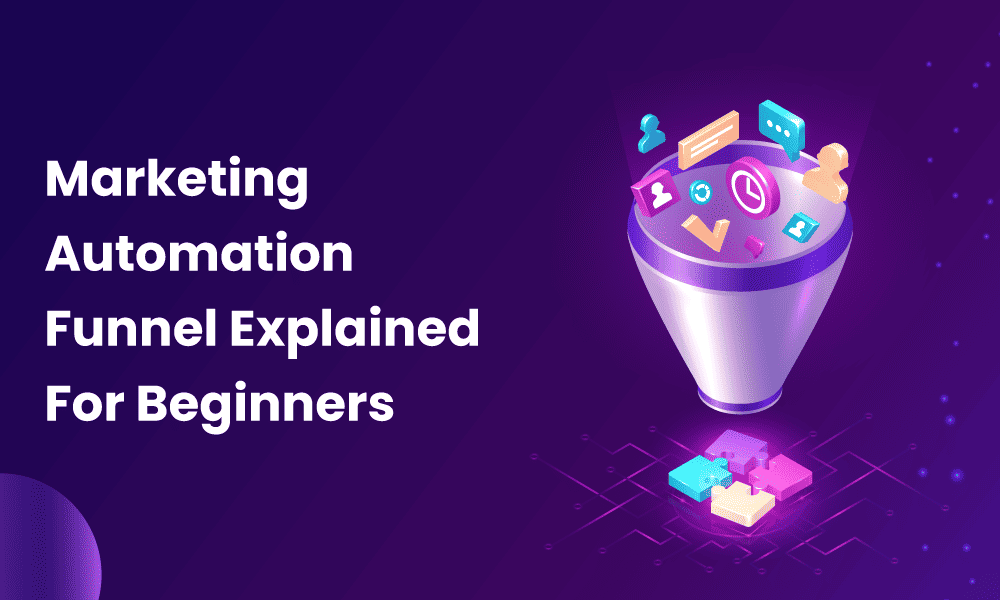In a world where consumer preferences are in constant flux, businesses must pivot their marketing strategies to remain competitive. The challenge lies in crafting a customer journey that truly resonates with your target audience.
To meet this challenge head-on, savvy marketers have introduced the concept of funnels, which simplifies the customer journey. Think of it as sculpting your ideal customer journey into a funnel shape.
At the wide top, you cast a net to capture potential leads. As they progress downward, you serve them precisely what they need at the right moment, ushering them closer to conversion. This, in essence, is the art of the marketing funnel.
But, wait – this isn’t your traditional funnel. With the power of marketing automation, we’re ushering this concept into a whole new era. In this post, we will embark on a journey through the evolution of the marketing funnel and discover how automation is reshaping the playing field.
Table of Contents
What Is a Marketing Automation Funnel?
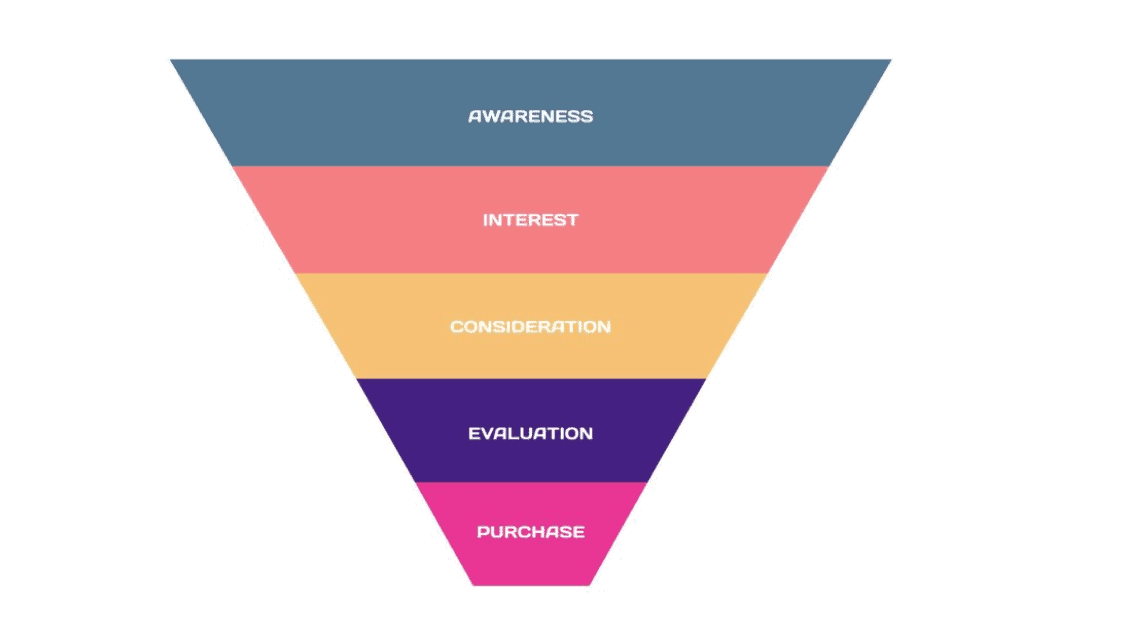
In the era of modern marketing, a marketing automation funnel stands as a vital construct. But what exactly is it, and why is it important in today’s marketing landscape?
At its core, a marketing automation funnel is a conceptual framework that represents the customer buying journey from initial awareness of a product or service to the ultimate goal of conversion, which could be a purchase, sign-up, or any desired action by the consumer.
It’s akin to guiding a prospective customer through a sequence of well-defined stages, nurturing their interest, and building a relationship.
An automated marketing funnel empowers businesses to deliver the right message at the right time, tailored to each individual’s unique needs and preferences.
It ensures that no prospect gets lost in the shuffle, and no opportunity goes untapped.
The Stages of a Marketing Automation Funnel
A marketing automation funnel, like any well-orchestrated journey, is comprised of several distinct stages. Each stage plays a crucial role in shaping the customer’s buying journey and bringing them closer to the ultimate goal.
While there’s no universal agreement on the exact structure of a marketing funnel, the most common version typically consists of the following stages.
Let’s embark on a journey through these stages, where automation transforms prospects into loyal customers.
Awareness
This is the top of the funnel, where potential customers first become aware of your brand, product, or service. Automation at this stage ensures that your audience receives relevant and captivating content, sparking their initial interest.
They might discover you through various channels, such as online ads, social media, or content marketing.
Interest
As prospects move down the funnel, they begin to show interest in what you offer.
Automation can assist by providing them with additional information through personalized emails, product recommendations, or targeted content that addresses their pain points. This keeps them engaged and moves them further down the funnel.
Consideration
In the consideration stage, potential customers are evaluating your product or service as a solution to their needs. This is where they might compare you with competitors, read reviews, or request more detailed information.
Automation facilitates this evaluation by delivering case studies, product demos, or customer reviews tailored to their interests.
Conversion
The conversion stage is the turning point. This is where leads make a decision and choose to purchase. The goal is to convert prospects into paying customers.
Using automation, you can ensure a seamless transition, simplifying the process and nurturing leads until they are ready to commit.
Retention
Once you’ve converted leads into customers, the relationship doesn’t end there. In the retention stage, your focus is on ensuring customer satisfaction and encouraging repeat business.
Automation tools help keep customers engaged through personalized follow-up emails, excellent customer service, or targeted offers to cultivate loyalty and encourage repeat business.
Advocacy
Automation can prompt satisfied customers to share their experiences, turning their advocacy into a powerful growth driver.
Happy customers can become your brand advocates. They promote your business through word-of-mouth, social sharing, or leaving positive reviews. Advocacy is an often overlooked but vital part of the funnel.
It’s important to note that marketing funnels can vary from one business to another.
Some marketers employ more complex funnels with additional stages, while others keep it simpler. The actions taken by both businesses and consumers at each stage can also differ.
However, the commonality lies in the core idea of guiding potential customers through a journey, from initial awareness to becoming loyal advocates of your brand.
Read also: Sales Pipeline vs Sales Funnel: Yes, They’re Two Different Things
Examples of Marketing Automation Funnel in Action
Now, let us look at some excellent examples of the marketing automation funnel used by major brands.
Amazon
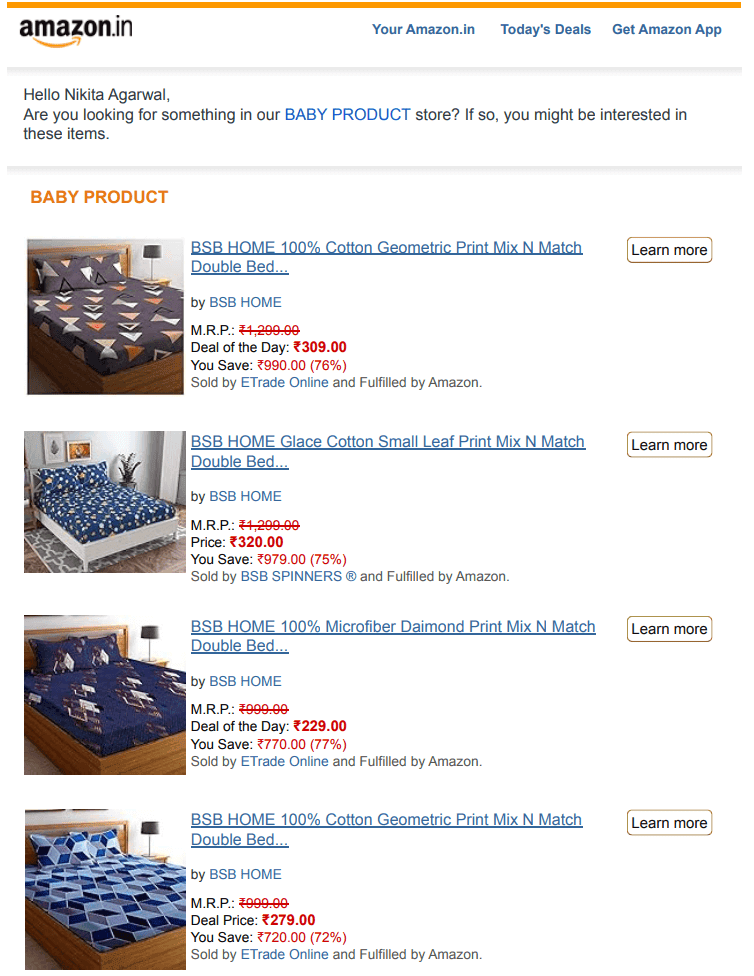
Amazon, being one of the largest eCommerce brands, serves as an ideal example for illustrating the concept of a marketing automation funnel.
Once you’ve signed up with Amazon, whether you’ve made a purchase or not, the platform starts tracking your browsing history and meticulously analyzes your online behavior and preferences.
This initial phase can aptly be labeled the ‘Interest’ stage, and it’s where Amazon excels in delivering personalized product recommendations.
These recommendations aren’t confined to the Amazon website alone. They extend into your inbox with tailored product suggestions via email, and they subtly appear as on-site prompts during your visits.
It’s this intricate automation that keeps users engaged and encourages them to explore more, ultimately moving them closer to conversion.
But how does Amazon ensure that existing customers keep returning for more? In addition to product recommendations, Amazon employs another ingenious strategy by regularly sending out exclusive offers through email.
This approach keeps their customer base continually engaged and entices them to return for additional purchases.
Club Vistara
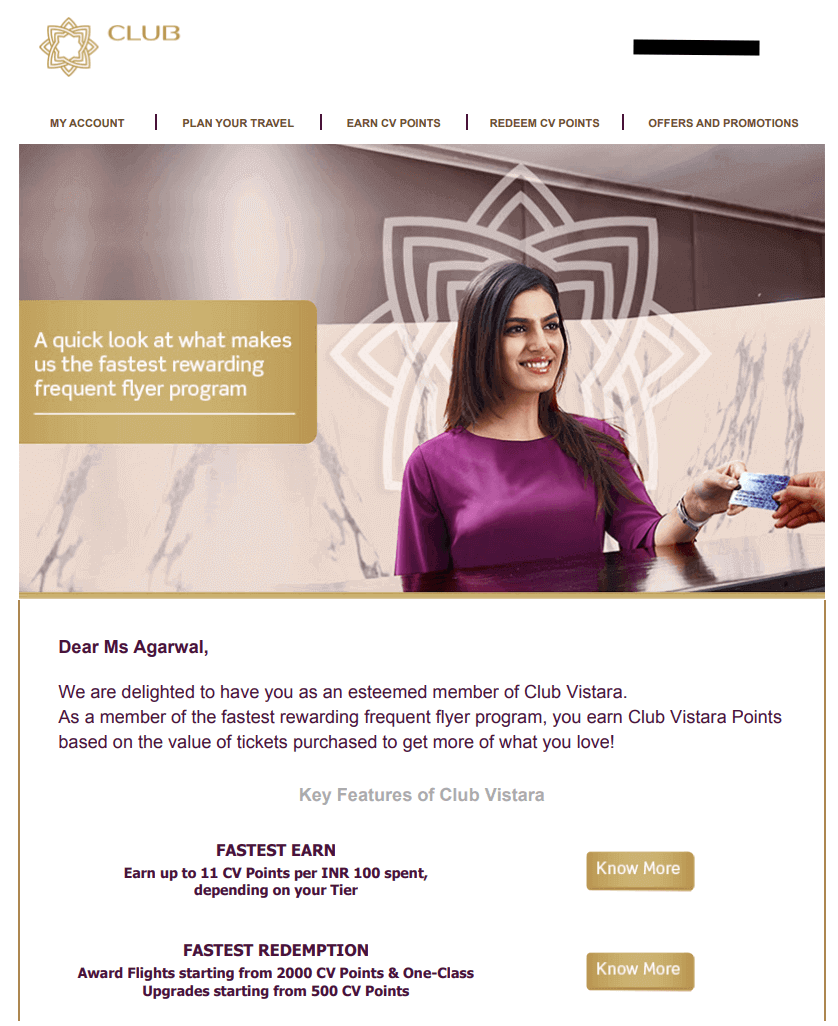
Club Vistara, the loyalty program offered by Vistara, one of India’s leading airlines, is a prime real-life example of how an effective loyalty program can foster brand advocacy and customer loyalty.
Club Vistara takes customers through the various stages of a marketing automation funnel.
When a passenger signs up, Vistara begins tracking their travel history and preferences, entering them into the ‘Interest’ stage.
As travelers accumulate flights, they receive personalized emails with flight recommendations, cabin class upgrades, and exclusive discounts – a prime example of automation in the ‘Consideration’ stage.
They have a tier-based membership – ‘Silver,’ ‘Gold,’ and ‘Platinum,’ each offering higher benefits as members move up. This progression reflects the nurturing phase, as more loyal customers are rewarded with additional benefits like bonus CV Points and priority waitlisting.
This approach enhances engagement and guides members closer to conversion, encouraging them to book more flights.
As members continue to fly and accrue CV Points, they can redeem them for free flights, hotel stays, and more, effectively retaining their loyalty. This automation not only sustains customer engagement but also creates a pool of loyal advocates who actively refer friends and family to the airline, demonstrating the power of a well-structured marketing automation funnel.
Club Vistara leverages email automation and personalization to keep members informed about their tier status, exclusive offers, and their earned CV Points. This ensures that customers receive timely and relevant communication throughout their journey with the program.
Read also: eCommerce Sales Funnels 101: A Beginner’s Guide
Benefits of Implementing a Marketing Automation Funnel
By automating the marketing funnel, you can experience a wide range of benefits that help revolutionize how businesses engage with their customers and operate in the digital age.
Here are some key advantages to look out for.
Streamlined customer journey
A marketing automation funnel provides a structured path for potential customers – guiding them through the stages of awareness, interest, consideration, conversion, and delight.
It ensures that each prospect receives the right message at the right time, streamlining their journey and providing a cohesive and engaging experience.
Increased funnel conversion rate
An automated marketing funnel optimizes the lead nurturing process. By delivering personalized content, automating follow-up interactions, and identifying high-value leads through lead scoring, businesses can significantly increase their conversion rates.
Leads are more likely to progress through the funnel when relevant content is delivered efficiently.
Read also: 5 Customer Journey Mapping Examples (With Exclusive Expert Insights)
Optimized resource allocation
Marketing funnel automation empowers businesses to allocate resources more efficiently. By automating repetitive tasks and processes, such as lead qualification and email campaigns, companies can liberate valuable human resources and amplify their productivity.
Additionally, it provides a clear insight into the number of leads in the pipeline and the requisite number of sales representatives to achieve the desired results. This aids the sales team in maintaining preparedness, ensuring they have an adequate team size rather than scrambling to hire at the last minute to meet their goals.
Better data collection and analytics
Automation tools collect a wealth of data throughout the customer journey. You can leverage this data for better decision-making, content optimization, and understanding of customer behavior.
Advanced analytics and reporting capabilities enable businesses to measure the effectiveness of their marketing efforts and make data-driven adjustments to improve performance.
Read also: Sales Pipeline Stages Every Business Should Use
How to Use Marketing Funnel Automation for Maximum Conversions
Businesses of all sizes face the challenge of converting potential leads into loyal customers. However, an automated funnel can help streamline and optimize the customer journey.
This guide will walk you through the process of using marketing funnel automation to nurture conversions and drive success in your marketing efforts.
Step 1. Defining your target audience
Precision matters in marketing. To effectively utilize a marketing automation funnel for conversion, it’s essential to have a clear understanding of your audience.
Start by conducting comprehensive research to gather demographic and psychographic data of your prospects. Gain insights into your audience’s needs, preferences, behaviors, and pain points.
This deep understanding forms the foundation for creating content and strategies that resonate with your ideal customers.
Step 2. Mapping the customer journey
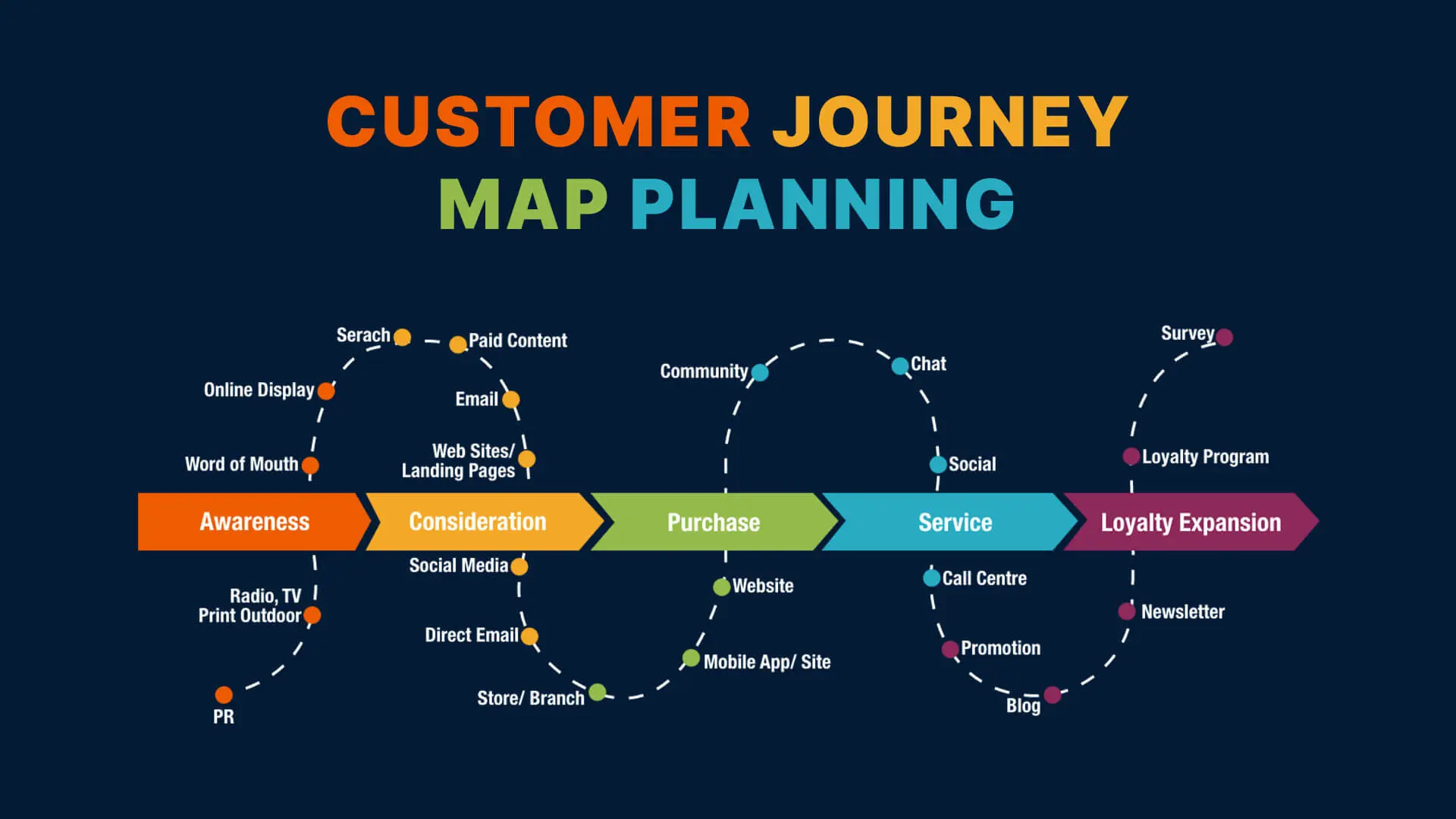
Once you have identified your audience, the next step is to map their journey. A well-mapped customer journey can help you optimize your marketing automation funnel and nurture conversions.
Mapping the customer journey is similar to creating a roadmap for your marketing strategy. It involves visualizing and understanding every interaction a customer has with your brand, from initial awareness to conversion.
This process allows you to strategically position touchpoints and content at each stage of the funnel, ensuring that your audience progresses seamlessly.
For instance, in the awareness stage, a potential customer might discover your brand through a social media ad. Now, the content you provide should address the specific needs and questions your audience has at that point in their journey. The social media ad could take them to a particular blog post or informative videos that introduce your brand and its offerings.
In the consideration stage, content could shift to eBooks, product comparisons, and other information that helps potential customers make informed decisions.
When they reach the conversion stage, the content might focus on testimonials, reviews, and persuasive offers to encourage them to take action.
Step 3. Automation for engagement
At this stage, you set up funnel automation to start engaging and interacting with your audience.
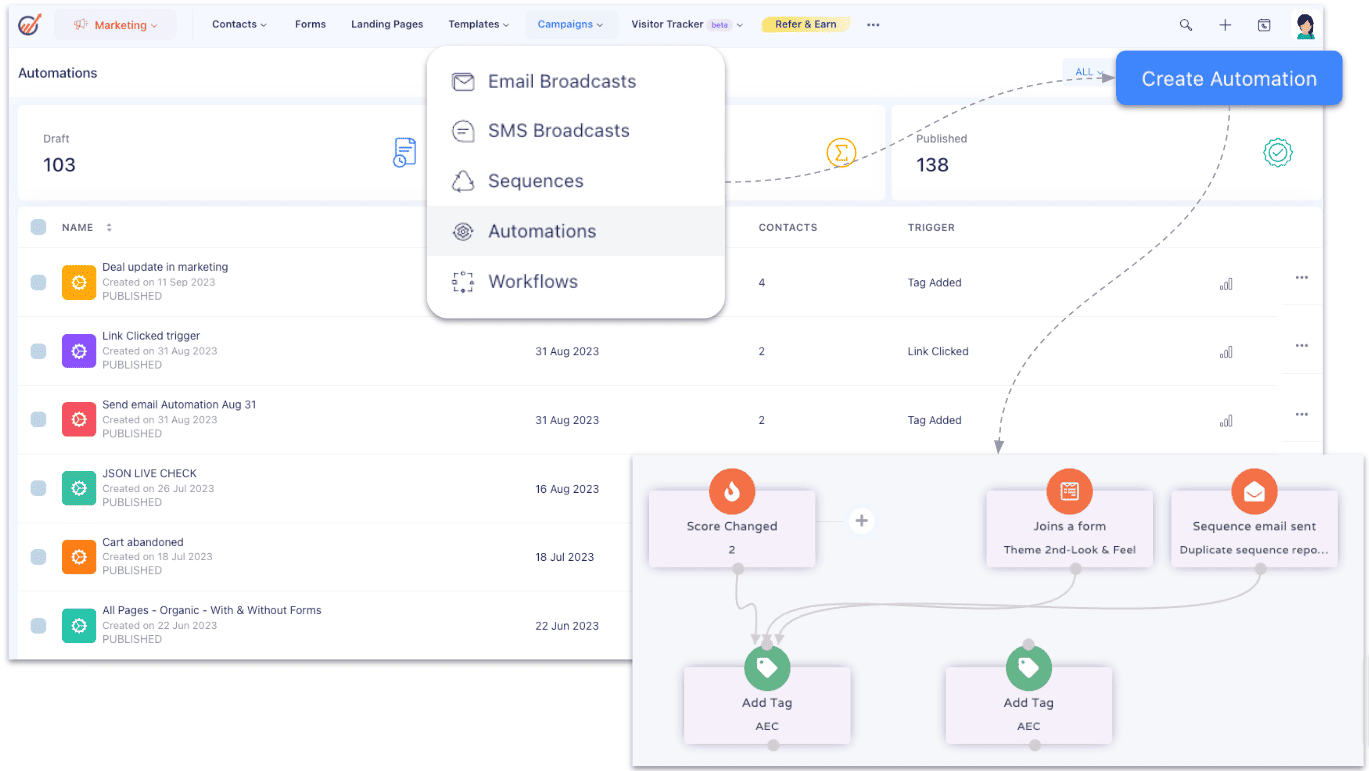
3.1 Lead generation and nurturing
A successful marketing funnel will help you attract and capture leads. Automation empowers this process by streamlining lead-generation efforts.
For instance, using marketing automation tools, you can create user-friendly forms and landing pages that streamline the data collection process. Similarly, AI-powered chatbots offer personalized interactions with website visitors and even collect contact information, all in real time.
And once you have attracted leads, the next challenge is nurturing them throughout the funnel. Automation facilitates this nurturing process by enabling the delivery of consistent and personalized content. Automated email sequences, tailored content recommendations, and strategically designed lead scoring systems are at the heart of nurturing leads throughout their journey.
This content is crafted to guide and engage leads from initial contact to the point of conversion, ensuring a consistent and personalized experience that resonates with their needs and preferences.
3.2 Personalization and segmentation
Personalization and segmentation is the key to keeping your audience engaged.
Personalization is the practice of tailoring your marketing efforts to each individual needs and preferences to increase the chance of conversion. On the other hand, segmentation is the strategic process of dividing your audience into distinct groups based on shared characteristics or behaviors.
With automation, you can create messages that resonate with each lead on a personal level. By analyzing their behavior, interactions, and history, you can understand their specific interests and needs and segment your audience into specific groups.
This knowledge enables you to deliver highly relevant content to each segment, addressing their pain points and aspirations. Personalization also extends to product or content recommendations. Automated algorithms can suggest products or content that align with a lead’s past actions or preferences.
For instance, if a lead or a segment of customers has shown interest in swimming gear, your system might recommend swimwear or related articles. This personal touch enhances the lead’s experience and drives engagement.
Step 4. Conversion and beyond
The next step in marketing funnel automation is to qualify leads and nurture them further for ultimate conversions.
4.1 Lead scoring and qualification
Once you have leads in your system, you need to qualify leads based on their engagement and readiness to convert.
By leveraging lead scoring, you assign numerical values to leads based on their behavior and interactions with your content and brand. This scoring system is automated and helps you identify which leads are most engaged and have a higher chance of conversion.
This lead qualification process ensures that your sales team focuses their energy and efforts on the most promising leads.
It’s about separating the ‘hot’ leads, who are close to making a purchase, from the ‘cold’ leads who need more nurturing. This automation funnel strategy streamlines your sales efforts, resulting in more effective conversion tactics.
4.2 Email marketing and CRM integration
Email marketing remains a pivotal tool for conversion and ongoing customer engagement. By leveraging automated workflows and triggers, you can ensure that your messages are delivered at the right time when they are most likely to capture the leads’ attention.
For instance, you can automatically send a welcome email immediately after a user signs up or a follow-up email when they interact with specific content.
But at the same time, tailoring your emails to individual recipient characteristics and behaviors can enhance engagement and conversion rates. This is where the CRM system comes into the picture.
Integrating your marketing automation platform with a CRM system ensures seamless lead management and a 360-degree view of customer interactions.
By harnessing CRM data, you can personalize your interactions with customers, making them feel valued and understood.
You can then easily run automated email sequences to onboard new customers and provide a responsive experience for each customer, fostering brand loyalty.
Step 5. Optimization and growth
Optimization and growth are the final steps in mastering marketing funnel automation.
Here, you need to harness the power of data, analytics, testing, and ongoing improvement to ensure your marketing funnel is effective and continually evolving to meet your audience’s needs.
5.1 Analytics and reporting
Data-driven decision-making is crucial in marketing automation.
Analytics and reporting provide the insights you need to make informed decisions. By tracking key metrics such as lead engagement, click-through rates, and conversion rates, you can gauge the effectiveness of your campaigns.
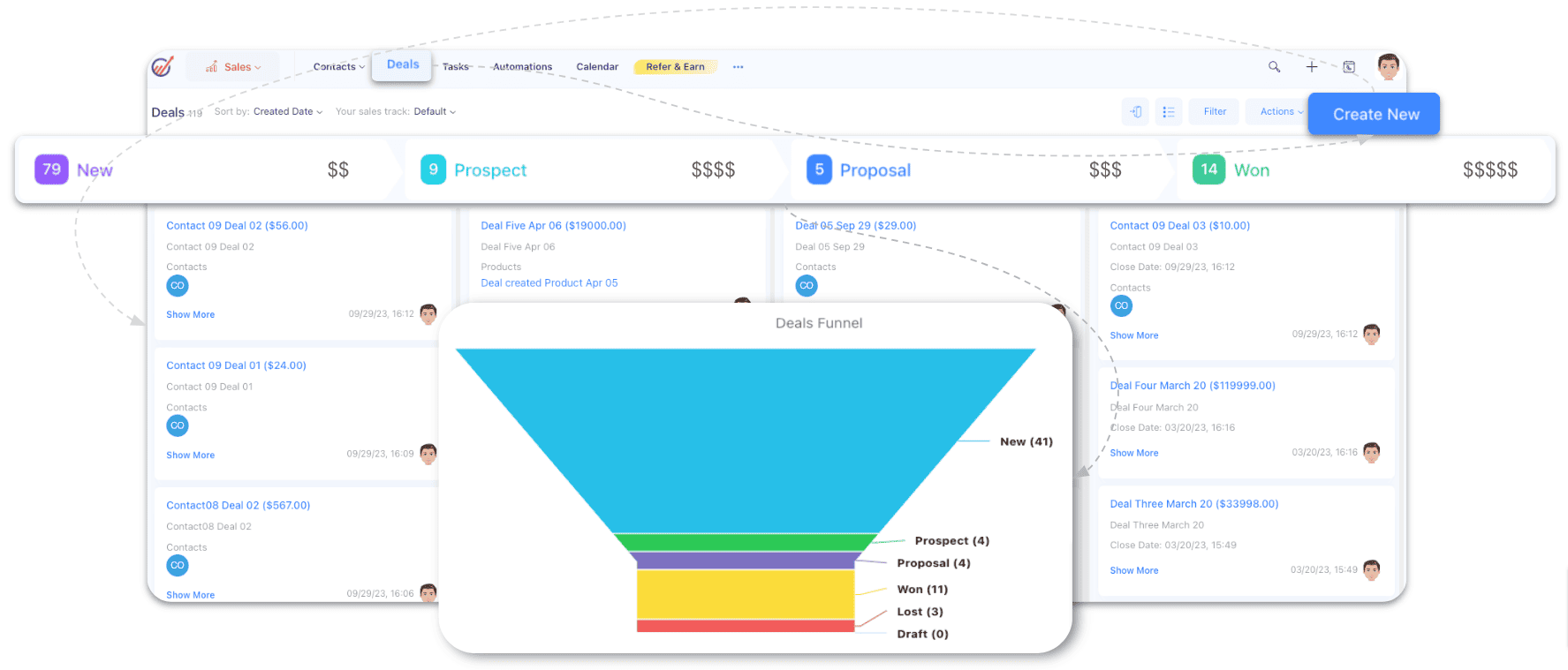
In other words, analytics allows you to evaluate your marketing funnel’s performance. You can identify what’s working and what needs improvement.
By understanding which channels, content, and messages resonate most with your audience, you can tailor your efforts for better results and allocate resources where they will have the most impact.
5.2 Testing and continuous optimization
Continuous improvement is the lifeblood of successful marketing funnel automation. A/B testing and ongoing optimization are the dynamic duo that ensures your funnel evolves in line with your audience’s ever-changing needs and demands.
Ongoing optimization means your marketing funnel is a living entity that adapts and grows. It’s about continuously refining your strategies and tactics based on what your audience responds to.
Using A/B testing, you can compare two variations of a campaign element to determine which performs better.
Whether it’s testing different landing page designs, email subject lines, or call-to-action buttons, A/B testing allows you to make data-based decisions for optimization. It’s a powerful tool for refining your marketing approach.
By analyzing the results of A/B tests and customer feedback, you can make data-driven adjustments that lead to better engagement and conversion rates.
Read also: Sales Pipeline Guide for Dummies (with relatable memes)
Best Practices for a Successful Marketing Automation Funnel
Creating a successful marketing automation funnel involves a combination of strategic planning, effective execution, and continuous refinement.
Here are some of the best practices that can help you with setting up a marketing automation funnel.
Selecting the right tools and platforms
Selecting the appropriate marketing automation tools and platforms is crucial.
Check for the tools that align with your specific automation goals, whether it’s lead generation, lead nurturing, or improved conversion rates. At the same time, it should be able to integrate with your existing systems seamlessly.
Integration streamlines data flow and ensures a cohesive user experience.
Additionally, tools with user-friendly interfaces and active support can expedite the implementation process.
Integration and setup
Setting up your automation system requires attention to detail. Here are a few things you need to be mindful of to ensure smooth integration and setup –
- Mapping workflows: Before implementation, map out your automation workflows. This clarifies the flow of leads and actions within your marketing funnel.
- Data management: Establish clear data management practices, including data segmentation, data cleansing, and data enrichment. Well-organized data is essential for successful funnel automation.
- Customization: Configure your automation platforms to align with your business processes. Tailor them to your unique needs and objectives.
- Quality assurance: Rigorously test all integrations and setups to ensure that your automation processes work as intended.
Plan your content strategy
Content is the lifeblood of your marketing automation funnel.
Develop high-quality content that addresses your audience’s problems at each stage of the funnel. This content should be engaging, educational, and shareable.
Map content to each stage of the funnel. Create content that guides leads through their journey, from awareness to conversion and delight. Ensure that your content is consistent in voice, tone, and branding to foster trust and recognition.
Multichannel approach
Don’t limit your automation efforts to a single channel. Utilize various marketing channels, from social media to SEO, to reach a wider audience.
Multichannel automation provides more touchpoints and enhances overall engagement.
Sales and marketing alignment
Ensure that your sales and marketing teams are aligned in their goals and strategies.
Collaboration between these two teams is essential to create a cohesive customer journey and maximize conversion rates. Encourage regular communication and shared insights between the departments.
Read also: Marketing Funnel and Everything You Need to Know About it
Wrap Up
Marketing funnel automation is a dynamic approach that adapts to the changing needs and preferences of your audience. The power of data, personalization, and efficiency that marketing automation provides is a force to be reckoned with in today’s competitive environment.
Embrace the potential of the marketing automation funnel, and watch your conversions soar.
If you are looking for an affordable and robust automation platform to fuel your marketing funnel strategies, EngageBay can help. With its user-friendly and intuitive interface, you can build and set up multiple workflows easily.
It’s even free for up to 15 users. Sign up for a free demo today.
